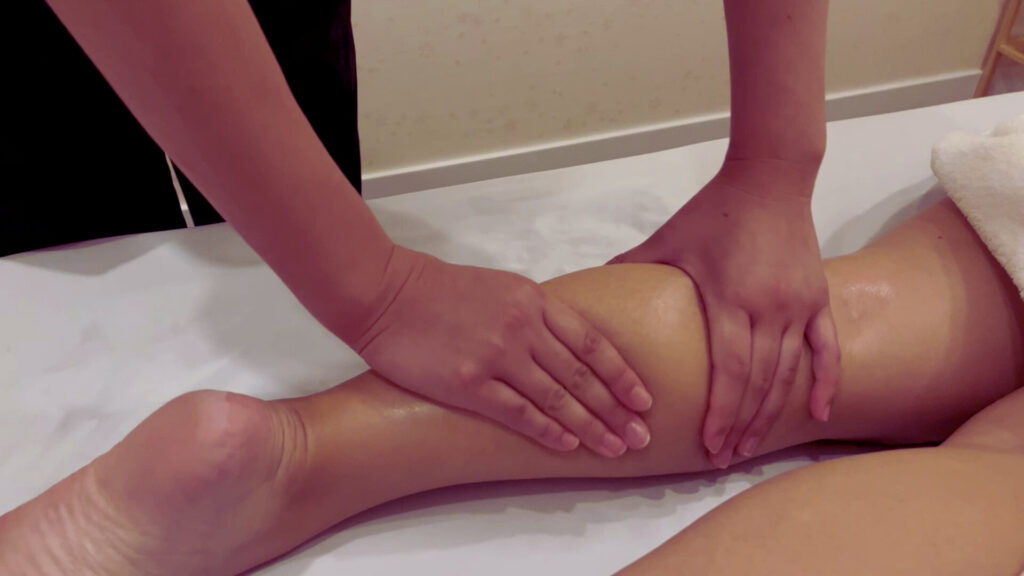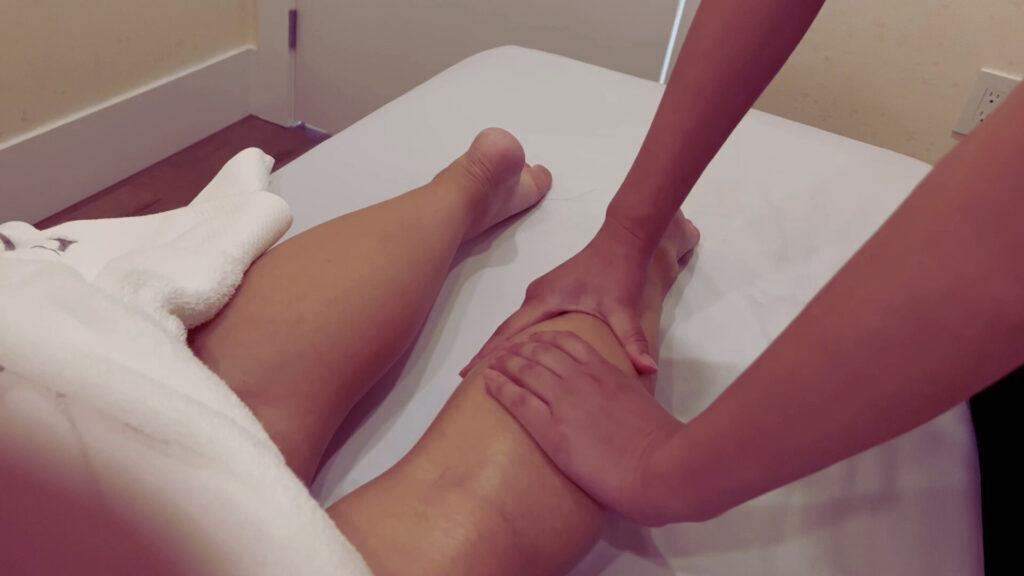Kneading is a massage technique that targets the deeper layers of muscle.
This article provides a comprehensive guide to kneading—covering its benefits, types, specific methods, and precautions.
- [Tsubaki Massage Technique 1] What Is Petrissage?
- [Tsubaki Massage Technique 2] What Is Kneading?
- [Tsubaki Massage Technique 3] What Is Effleurage?
- [Tsubaki Massage Technique 4] What Is Friction?
- [Tsubaki Massage Technique 5] What Is Holding?
What Is Kneading? Basics and Benefits
Kneading is one of the most important techniques in massage and bodywork. Rather than merely gliding over the skin, it firmly grasps and works the muscles and soft tissues, delivering a range of benefits. Its hallmark is a rhythmic alternation of compression and release that eases muscular tension and promotes circulation.
Kneading requires practitioner skill and experience. When performed with appropriate pressure and rhythm, it can deliver superior results.

Definition and Characteristics of Kneading
“Kneading” derives from the Latin gnedere (“to knead”). As the name suggests, it involves working the muscles and tissues much like kneading dough.
Its key characteristic is the rhythmic cycle of compression and release, which targets deeper muscle layers to relieve tension and improve circulation. Kneading is performed with the pads of the fingers and the whole palm, and it has multiple variations depending on the area treated and the goal of the session.
For example, you may grasp larger muscle groups to work them broadly, or apply more focused pressure with the fingertips. Kneading is also frequently combined with other massage techniques, making it an essential component of effective treatments.
Kneading requires practitioner skill and experience; using appropriate pressure and rhythm helps maximize its effects.
Primary Benefits of Kneading
Kneading can deliver a variety of outcomes, including relief of muscular tension, enhanced circulation, and reduction of pain. By easing tight muscles, it can help alleviate chronic discomfort such as shoulder or low-back pain. Improved circulation supports the removal of metabolic waste and aids recovery.
It may also help balance the autonomic nervous system, deepening relaxation and reducing stress for overall well-being.
Additionally, kneading supports recovery from post-exercise fatigue and can reduce swelling.
These effects are thought to be amplified when the compression–release rhythm syncs with the body’s natural rhythms.
Appropriate kneading benefits not only the body but also the mind.
Circular Kneading and Wringing
Among the many kneading methods, two representative styles are circular kneading and wringing.
Circular kneading uses the pads of the fingers or the palms to work the muscles in small, circular motions. It readily reaches deeper layers and efficiently relaxes broad areas.
Wringing loosens tissues by rhythmically moving them side to side, like twisting a towel. It helps reduce tension and increase flexibility.
These methods are selected according to the treatment area and objective and are essential for delivering more effective sessions.
Circular kneading is well suited to larger regions such as the shoulders and back, while wringing is effective for narrower muscle groups like the neck and arms.
Types and Methods of Kneading
Kneading encompasses a variety of techniques chosen according to the area and purpose of treatment.
Basic methods include:
• Finger kneading using the pads of the fingers,
• Palm kneading using the entire palm,
• Thumb kneading using the thumbs
and more.
Finger kneading is ideal for smaller areas or reaching deeper layers.
Palm kneading is suited to rhythmically working broader regions.
Thumb kneading is useful for applying focused pressure to a single point.
At Tsubaki, we combine these methods to deliver more effective treatments.

Basic Procedure for Kneading
Before kneading, warm the treatment area with a hot towel to relax the muscles. Once sufficiently warm, apply oil to reduce friction.
Then use the pads of the fingers and the palms to gently grasp the muscles and knead them rhythmically. Alternating compression and release eases tension and increases circulation.
After the technique, wipe with a hot towel again or finish with light strokes to help the muscles relax.
Area-Specific Tips
Kneading can be applied across the body, but the ideal technique and pressure vary by area.
For broad regions such as the shoulders and back, palm kneading works well. Using the whole palm in rhythmic motions helps release tension.
For narrower muscles like the neck and arms, use finger kneading. The fingertip pads allow careful work into deeper layers.
For the legs and lower back, thumb kneading is effective. Applying focused pressure with the thumbs helps loosen stubborn knots.

Three Key Benefits of Kneading
Kneading offers multiple advantages. Notable among them are deep muscular relaxation and relief of stiffness, improved blood and lymphatic circulation, and greater muscular flexibility with an expanded range of motion. These outcomes are closely interrelated and collectively promote overall health.
Kneading is more than a technique—it is most effective when grounded in a solid understanding of anatomy and function.
Deep Relaxation and Relief of Stiffness
By addressing deeper muscle layers and releasing tension, kneading produces profound relaxation. Tight muscles can compress blood vessels and limit circulation, leading to stiffness and pain. As kneading relaxes the muscles, this compression eases, blood flow improves, and discomfort is reduced.
Kneading may also influence the nervous system and help balance autonomic activity, enhancing relaxation and reducing stress to support mental and physical well-being.
Additionally, kneading can increase flexibility, helping prevent injuries and improve athletic performance.
Enhanced Blood and Lymphatic Flow
By mechanically working the tissues, kneading stimulates blood vessels and promotes circulation, delivering oxygen and nutrients throughout the body and activating cellular processes. It also supports the removal of waste products and can speed recovery from fatigue.
Furthermore, kneading encourages lymphatic flow. The lymphatic system is essential for immune function and waste removal; improved flow can support immunity and make the body more resilient.
When lymph stagnates, swelling can occur; kneading helps alleviate this by improving lymphatic drainage.
Greater Flexibility and Range of Motion
Kneading increases muscular flexibility and expands joint range of motion. Stiff muscles can restrict joint movement, narrowing overall mobility. As kneading softens the tissues, joints move more smoothly and range improves.
With greater range of motion, daily activities become easier and athletic performance can improve. It also contributes to injury prevention.
Kneading can also help balance muscular relationships. Imbalances may contribute to poor posture and undue strain; by restoring balance, kneading supports proper alignment and reduces bodily stress.

